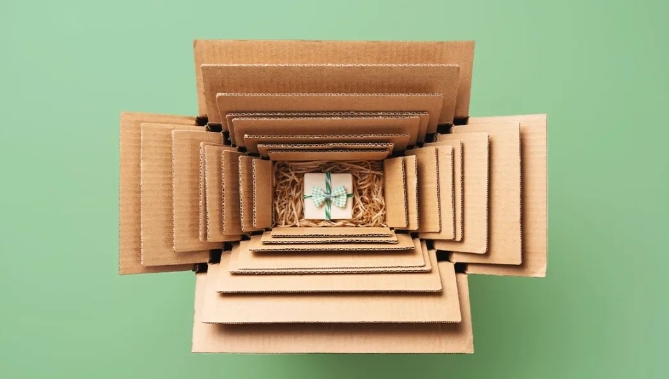Behind paper packaging lies an eco-friendly illusion
2023-12-17

It is widely acknowledged that plastic packaging has an adverse impact on the environment.
Over an extended period, mainstream media and environmental advocacy groups have highlighted the dangers of plastic products, including their detrimental effects on marine life and the accumulation they cause in landfills. In contrast, paper is often touted as a sustainable and eco-friendly alternative material. However, in reality, landfills in the United States receive more than six million tons of discarded paper packaging annually.
Regardless of whether it is due to genuine environmental concerns or widespread consumer criticism of plastics, numerous companies have invested significant resources in reducing their use of plastic packaging. For instance, Unilever has pledged to halve the use of non-recyclable plastics by 2025, while the British supermarket chain Tesco has launched a sustainable packaging initiative to cut the use of 1.5 billion pieces of plastic packaging, thereby reducing its annual packaging carbon footprint. Such endeavors indeed have the potential to yield positive environmental outcomes. However, another trend spurred by the anti-plastic movement – excessive packaging – counteracts these efforts. An increasing number of brands are adding paper layers to their plastic packaging to appear more environmentally friendly, but in reality, this does not reduce plastic waste.
Take, for example, the moisturizing lotions sold by the skincare brand Nivea, which are packaged in plastic bottles with an additional paper carton. There is also a similar product that is sold just in the plastic bottle form. Sensodyne toothpaste is usually sold in the combination of a plastic tube with an additional paper box, although it could be sold without the paper packaging. Despite the fact that such excessive packaging increases manufacturers’ costs and has a greater environmental impact, it is a pervasive practice seen across different product categories and geographical markets.
Unfortunately, corporations have compelling reasons to adopt such evidently problematic strategies: they are effective. Through eight surveys encompassing over 4,000 participants from the United States, the United Kingdom, and the Netherlands, we found that consumers perceive plastic packaging with an added paper layer to be more environmentally friendly than purely plastic packaging. In other words, even though people can see the same plastic packaging being used, adding a paper layer directly to plastic packaging makes the product seem more eco-friendly. This perception subsequently sways consumers to prefer certain products and be willing to pay more for them. For instance, in one survey, participants were willing to pay an average of 15 cents more if a paper layer was added to the existing plastic packaging of a Granola bar.
Interestingly, our findings also indicate that factors determining perceptions of sustainability are not limited to the presence of paper packaging but also include the relative proportions of plastic to paper packaging. For all survey participants, with the plastic packaging remaining constant, we simply adjusted the proportion of paper packaging, and subsequently, their perceptions of the product’s eco-friendliness increased with a higher percentage of paper.
The subtlety of the excessive packaging trend stems, in part, from the fact that this misconception prevails particularly among the most environmentally conscious consumers. Interests in sustainability vary with political affiliations and national contexts, and we have found that those who claim to adopt more eco-friendly measures are also more likely to perceive excessively packaged products as environmentally superior. Ultimately, the very consumers who desire to propel companies towards sustainable practices may unwittingly encourage environmentally harmful excessive packaging.
The good news is that excessive packaging is not the sole means to demonstrate sustainability or attract eco-conscious consumers. Our research has uncovered that, in addition to extra paper packaging, simply adding a “minimal packaging” label to plastic packaging can correct the misconception that over-packaged products are more sustainable. This is particularly important for products that utilize plastic packaging to ensure safe transport and shelf life, as such explicit information can alleviate consumer biases against responsible use of plastic packaging (without generating unnecessary paper waste).
This information proves effective because, aside from the prevailing narrative that “plastic is the devil,” consumers are increasingly recognizing the importance of targeting minimal packaging itself as a goal. Indeed, according to a recent survey by Deloitte, over half of respondents indicated that they consider products with minimal or recyclable packaging to be sustainable, irrespective of the packaging material. Many brands have incorporated this trend into their strategies, explicitly advocating for their commitment to responsible packaging with slogans like Zara’s “Our boxes are made of boxes with a past,” Kiehl’s online declaration that most of its products do not require “secondary packaging,” and the “compostable packaging” label on 12 Tides chip packets.
Of course, such marketing efforts must be backed by tangible investments in sustainability. Moreover, the use of “minimal packaging” labels must be predicated on the premise that the brand truly employs the simplest form of packaging possible, preferably under the oversight of a trade organization or regulatory body with clear, consistent standards. Nevertheless, for businesses seeking more responsible packaging while also ensuring that their products appear environmentally friendly, using the “minimal packaging” label directly is a superior approach to the increasingly common – and evidently harmful – practice of excessive packaging.




